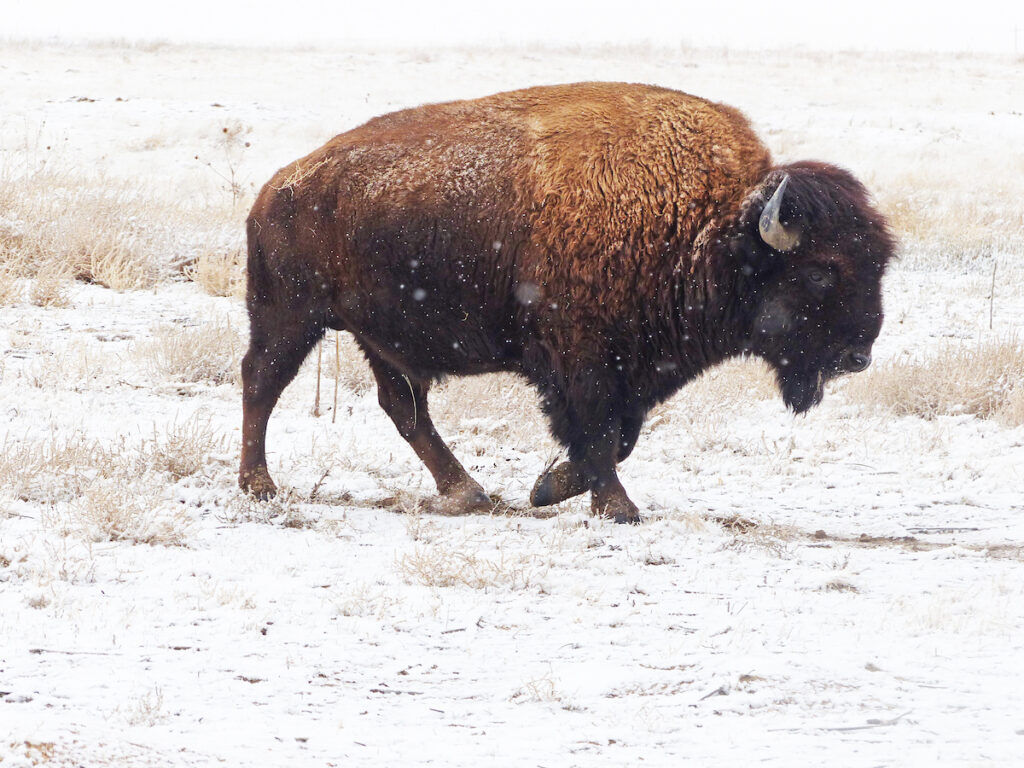Following new management decisions, what’s next for bison in Colorado?

Could bison one day roam free again in Colorado?
And could they be hunted, perhaps recalling a grim chapter in Western history?
These were questions and concerns of several advocates who commented at the latest Colorado Parks and Wildlife Commission meeting, during which the rule-setting board approved new management for the iconic animal mostly gone from its native range.
Bison seen in Colorado are fenced in, part of conservation herds or raised as livestock ー as they’ve been classified and managed under the state Department of Agriculture. Now, following legislation signed by Gov. Jared Polis and additional regulations recently set by the CPW Commission, bison will also be managed as wildlife.
“This dual classification recognizes both the cultural and ecological importance of bison while providing the tools needed to manage wild bison as big game wildlife,” CPW Big Game Manager Andy Holland said in a statement.
And like other big game ー such as elk, deer, moose and bighorn sheep ー bison should be allowed to roam across Colorado, advocates insisted during the commission meeting. Additionally, some implored, they should be brought back to their native grounds.
Signed by Polis in May, Senate Bill 25-053 “finally recognizes buffalo as a native species,” said Rainer Gerbatsch, “but the recognition alone is not necessarily restoration.”

Gerbatsch was among advocates who spoke on the 19th-century slaughter of bison amid westward expansion and the lingering pain among Native people with deep, cultural ties to the animal. Said another advocate who similarly called for restoration: “Now that bison are migrating into our state, we have an opportunity to do right by the species.”
From a restored range in Utah, bison in suspected small numbers have long been wandering over to remote areas north of Grand Junction, around the Book Cliffs.
“When they did, they were unprotected,” Holland said in a Gazette interview, explaining the new wildlife classification.
CPW could not previously enforce against those bison being killed ー 12 reportedly in the last decade ー but now the agency can. SB 25-053, also called the Protect Wild Bison Act, adds bison to big-game species that can only be hunted with a license; the legislation lists punishments of fines and imprisonment.
“It was enacted to prevent poaching of the Book Cliffs bison,” CPW Commissioner Dallas May stressed at the recent meeting, following feedback that lingered on concerns over hunting.
The concerns were based on approved regulations regarding a potential bison hunt. CPW has announced it is “developing a registration process for interested hunters to join a management roster, which could be used if needed to manage a free-ranging herd.” The announcement continued: “That process, including a public application form and drawing system, is expected to be available in January 2026 through the CPW website.”
But these would only be “management licenses” issued in a “very specific instance,” Holland emphasized. “To prevent game damage, or maybe there’s some harvest for disease surveillance. … Honestly, these are director-approved hunts we hope we don’t have to use.”
During the commission meeting, one remembered Lakota activist Rosalie Little Thunder: “Rosalie believed the continuation of the slaughter, even when disguised as management, was a tragic and senseless continuation of past historical violence against the herds.”
Others praised what they saw as a proactive approach by CPW. That included Dallas Gudgell, who has advocated for bison restoration as a member of the Fort Peck Assiniboine and Sioux tribes.
“But I’m hoping we slow this process down until tribes are involved,” Gudgell told the CPW Commission. He expressed another hope: “If and when in years from now you got 500 bison in your state roaming around, that tribes get priority for their usual, custom, aboriginal food source.”

The Protect Wild Bison Act was born out of a proposal by the American Indian Affairs Interim Study Committee, the legislative council formed last year. In its own words, the act “represents a step toward making amends for the attempted genocide of American Indians through the eradication of their food source, the bison.”
More tribal consultation would happen over the next year or two, Holland said. That’s as CPW convenes stakeholders over what the agency is calling a Book Cliffs Bison Herd Management Plan.
First, wildlife managers need to get a better idea of numbers crossing into the state, Holland said. He said Utah’s occasional migrators have been members of a “sub herd” of about 130 bison.
“And then another important piece is a forage and range conditions assessment,” Holland said. This would inform CPW’s ultimate aim, he said: “What an extension of the Book Cliffs herd looks like in Colorado, what that geographic area would be, and what the population objectives would be in Colorado.”
As for a broader restoration? This was a question CPW heard from lawmakers in the legislative process ー while officials also heard from ranchers worried about grazing competition, fence damage and disease transmission.
“We have been very clear, we have no intention to translocate bison anywhere,” Holland said. “We’re focused on the Book Cliffs area.”
That area alone stirred the imagination of CPW Commissioner Murphy Robinson. As he said at the recent meeting: “I’m looking forward to the day I can be out on the landscape and see bison just roaming and being out there as part of our landscape again.”
Get OutThere
Signup today for free and be the first to get notified on new updates.






